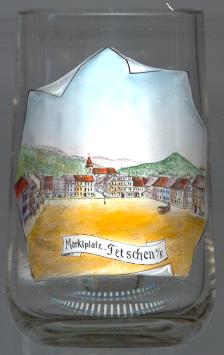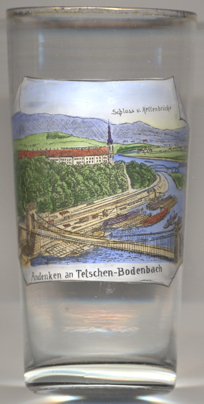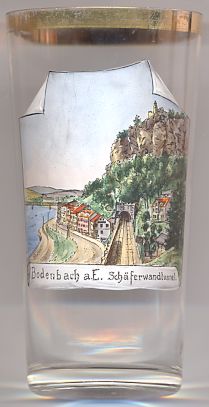

|
| ČESKÁ REPUBLIKA | CZECH REPUBLIC |
| Ústecký kraj | Ústí nad Labem region |
| Okres: Děčín |
 Děčín is situated at an elevation of 135 m on the river Labe (Elbe), about 17 km
northeast of the regional capital Ústí nad Labem and about 80 km north-northewest of
Prague. The municipality has a population of about 47,200 (2023).
Děčín is situated at an elevation of 135 m on the river Labe (Elbe), about 17 km
northeast of the regional capital Ústí nad Labem and about 80 km north-northewest of
Prague. The municipality has a population of about 47,200 (2023).
The history of Děčín goes back to the 10th century when a castle of the Přemyslides stood on this place as a toll station. The first mention in a written document dates from 1128 (as Daczin). Prior to 1283 it obtained the status of a royal town. In 1628 Děčín came into possession of the Counts Thun, later Counts and Princes Thun-Hohenstein. Large fires destroyed great parts of the town in 1682, 1714 and 1749. Emperor Joseph II visited the town in 1778. As he found that the location was not suitable enough as a defence fortress, he ordered that a new fortress be built at Terezín (Theresienstadt). The fortifications of Děčín were pulled down during the early 19th century. In 1942 Děčín was merged with Podmokly (Bodenbach) and Staré Město (Altstadt); until 1945 the name of the town was then Děčín-Podmokly (Tetschen-Bodenbach).
The  market square [left, no. 571] is the centre of the old town.
Until 1885 the Loreto Chapel of 1670 with the vault of the Thun-Hohenstein family stood
in the centre of the square. Today the square is called Masarykovo náměstí after the
first President of Czechoslovakia, Tomáš Garrigue Masaryk (1850–1937).
Not depicted on the glass is the fountain which was erected on the square in 1907.
market square [left, no. 571] is the centre of the old town.
Until 1885 the Loreto Chapel of 1670 with the vault of the Thun-Hohenstein family stood
in the centre of the square. Today the square is called Masarykovo náměstí after the
first President of Czechoslovakia, Tomáš Garrigue Masaryk (1850–1937).
Not depicted on the glass is the fountain which was erected on the square in 1907.
The  church Svatý Václav (St. Wenceslav)
[left, no. 571: background] was built in late Baroque style after the fire of 1749.
church Svatý Václav (St. Wenceslav)
[left, no. 571: background] was built in late Baroque style after the fire of 1749.

 Děčín castle [near left: no. 3799: background]
is probably the most popular tourist attraction in the city. Built on a hill near the city centre and overlooking the Labe
(Elbe) River, the castle has had an extremely varied history. In the 12th century it was constructed as a wooden fort,
and replaced by a royal stone castle in the 13th century. In the 16th century, a grand Renaissance palace was
constructed on the site, to be renovated in the Baroque style from the 17th century onward. A last major renovation was
completed in 1803. The castle was in possession of the Imperial counts Thun and Hohenstein from the 17th century until
1932 when the family sold it to the Czechoslovak state. From 1934 it was used as army barracks. Since 1991 it is owned
by the city of Děčín.
Děčín castle [near left: no. 3799: background]
is probably the most popular tourist attraction in the city. Built on a hill near the city centre and overlooking the Labe
(Elbe) River, the castle has had an extremely varied history. In the 12th century it was constructed as a wooden fort,
and replaced by a royal stone castle in the 13th century. In the 16th century, a grand Renaissance palace was
constructed on the site, to be renovated in the Baroque style from the 17th century onward. A last major renovation was
completed in 1803. The castle was in possession of the Imperial counts Thun and Hohenstein from the 17th century until
1932 when the family sold it to the Czechoslovak state. From 1934 it was used as army barracks. Since 1991 it is owned
by the city of Děčín.

The  Emperess Elisabeth bridge [near left: no. 3799: foreground]
was a chain bridge that spanned the river Elbe (Labe) between Tetschen (now Děčín) on the east bank
with Bodenbach (Podmokly, today part of Děčín). The bridge was opened in 1855 and was named for
Empress Elisabeth of Austria. When a railway line was opened connecting Dresden and Prague on the west bank of the Elbe in
1851, it became commercially vital for Tetschen on the east bank of the river to be connected to the station in Bodenbach.
The bridge was built from 1853 to 1855. When it was opened in 1855, it was the only chain bridge over the Elbe. The bridge
was regarded as one of the greatest and most beautiful bridges in Bohemia, and was favorably compared to the Széchenyi
Chain Bridge in Budapest. After World War I the bridge, largely built from wood, was hard to
maintain and no longer fit for growing traffic. It was demolished in the early 1930s, and replaced in 1933 by a new bridge
which retained the original pier footings. Today it is named Tyrš Bridge (Tyršův most) after
the Czech art historian Miroslav Tyrš.
Emperess Elisabeth bridge [near left: no. 3799: foreground]
was a chain bridge that spanned the river Elbe (Labe) between Tetschen (now Děčín) on the east bank
with Bodenbach (Podmokly, today part of Děčín). The bridge was opened in 1855 and was named for
Empress Elisabeth of Austria. When a railway line was opened connecting Dresden and Prague on the west bank of the Elbe in
1851, it became commercially vital for Tetschen on the east bank of the river to be connected to the station in Bodenbach.
The bridge was built from 1853 to 1855. When it was opened in 1855, it was the only chain bridge over the Elbe. The bridge
was regarded as one of the greatest and most beautiful bridges in Bohemia, and was favorably compared to the Széchenyi
Chain Bridge in Budapest. After World War I the bridge, largely built from wood, was hard to
maintain and no longer fit for growing traffic. It was demolished in the early 1930s, and replaced in 1933 by a new bridge
which retained the original pier footings. Today it is named Tyrš Bridge (Tyršův most) after
the Czech art historian Miroslav Tyrš.

The picture on glass no. 2208 [near left] shows a view of the
 railroad
railroad
Born in Děčín were:
Anton Kern (1709–1747) and Benedikt Kern (1713–1777), painters for the Royal Saxon Court in Dresden.
Leo Count Thun-Hohenstein (1811–1888), Minister for Education, reformed the education system in Austria-Hungary.
Miroslav Tyrš (Friedrich Emanuel Thiersch, 1832–1884), Czeh art historian and founder of the Czech gymnastic club Sokol (1862), which became an important factor in the revival of the Czech National movement.
Franz Anton Prince Thun-Hohenstein (1847–1916), 1898–1896 governor
of Bohemia, 1898/99 Prime Minister and Minister for Internal Affairs of Austria-Hungary.
He tried to reach a Bohemian settlement but had to resign in 1889 for obstructing
the German National parties.
[https://de.wikipedia.org/wiki/D%C4%9B%C4%8D%C3%ADn;
https://en.wikipedia.org/wiki/Děčín, https://de.wikipedia.org/wiki/Schloss_Děčín;
https://en.wikipedia.org/wiki/Empress_Elisabeth_Bridge;
https://en.wikipedia.org/wiki/Děčín–Dresden-Neustadt_railway]
![[scale]](lineal.jpg)